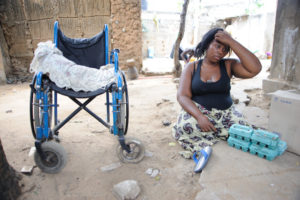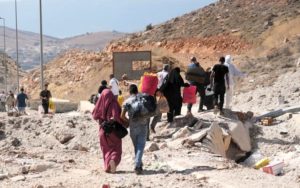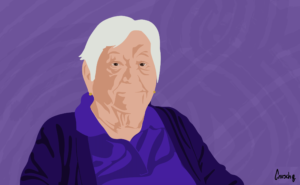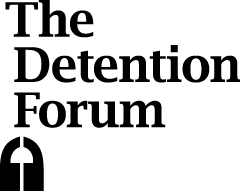On 23 May 2019, the UN Security Council will hold a debate to mark the 20th anniversary of the Council’s first debate and resolution (SCR 1265) on the Protection of Civilians in Armed Conflict. This article, adapted and updated from an account in the author’s book “Blinded by Humanity”, looks back at how it all started and assesses where we are now.
Background
In his book, “Deliver us from Evil”, published in 2000, William Shawcross offers a devastating account of the crises that confronted the UN in the 1990s. He recounts the agonies of ordinary people in Cambodia, Bosnia, Somalia, Rwanda, the DRC, Iraq, Afghanistan, Kosovo and East Timor and the often futile efforts of humanitarian workers of the United Nations, the Red Cross and NGOs to do something to help. Time and again UN peacekeepers were present in the countries where atrocities were taking place but were unable to do anything to stop the killings, either because their mandates did not authorise them to, or because they did not have adequate personnel or equipment.
But when, on 1 January 1997, Kofi Annan took up office as Secretary-General of the United Nations, after heading its Department of Peacekeeping Operations, the two cases which most fuelled the demands for a new approach were the massacre in 1995 in Bosnia of 7,000 men and boys at Srebrenica, and, above all, the Rwandan genocide in 1994. In both cases, UN peacekeepers were present, but were unable to stop the killing.
When the brilliant and charismatic Brazilian, Sergio Vieira de Mello, arrived at UN Headquarters from UNHCR to take over as Emergency Relief Coordinator in 1998, Annan had already published the results of investigations into the disasters in Rwanda and Bosnia, but still Sergio found himself briefing the Security Council all too frequently on the desperate conditions confronting civilians caught up in conflicts where UN peacekeepers were deployed. During his first year in the job, he found that he was repeatedly making the same points about the situations in different countries. So, the idea developed that he might address the Council, not on the situation in one country, but on the whole issue of the nature of humanitarian action during ongoing conflicts and its linkages to the role and responsibility of the Security Council for maintaining peace and security. The idea for such ‘thematic debates’ was quite revolutionary at the time, and it owes much to the skill and persistence of Annan and Vieira de Mello that the idea was accepted and is now seen as a normal part of the Council’s agenda.
On 21 January 1999, Sergio gave the Security Council an impassioned account of the appalling situations facing civilian populations and the humanitarian aid workers trying to help them. In doing so, he introduced most of the themes that were to become the elements of the debate on ‘the protection of civilians in armed conflict’. He spoke about unchecked violations of international humanitarian law in which civilians were the targets of military action; deplored the reluctance of the Security Council, in the wake of the debacle in Somalia, to authorise the peacekeeping operations that were required; stressed the need for access for humanitarian workers to places where civilians were in need of help; talked about the need to control ‘hate media’, which fomented violence against civilian populations; reminded the Council of the humanitarian impact of sanctions and the need for ‘smart’ sanctions that target individuals rather than entire communities; and, finally, he emphasised the terrible risks now being faced by humanitarian aid workers.
The first Security Council debate on the Protection of Civilians in Armed Conflict
On 12 February 1999, Lloyd Axworthy, Foreign Minister of Canada, whose diplomats had already been working with those of like-minded states on the issue, presided at a public session of the Security Council on the topic of ‘protection of civilians in armed conflict’, at which Cornelio Sommaruga, President of the ICRC, Carol Bellamy, Executive Director of UNICEF and Olara Otunnu, Special Representative of the Secretary-General for Children and Armed Conflict, introduced the debate. The meeting attracted so many member states and international organisations to speak that it had to be continued for a full second day. Sommaruga confronted the Security Council with its responsibility to provide the political solutions to the conflicts that were causing such unimaginable suffering. Bellamy and Otunnu presented shocking accounts of the consequences of modern warfare on children. The presidential statement of the Security Council issued on 12 February expressed the Security Council’s dismay at the situation and promised to address the problems. But the phrasing of the Council’s request to the Secretary-General reflected the extent to which its members recognised that there had to be more they could do, but also their genuine confusion about what that might be. In its statement, the Council said, that it “considers that a comprehensive and coordinated approach by member states and international organisations and agencies is required in order to address the problem of the protection of civilians in armed conflict. To this end, the Security Council requests the Secretary-General to submit a report containing concrete recommendations to the Council by September 1999 on ways the Council, acting within its sphere of responsibility, could improve the physical and legal protection of civilians in situations of armed conflict.”
Preparing the Secretary-General’s report
The UN Office for Coordination of Humanitarian Affairs (OCHA)’s policy branch, which I headed at the time, was tasked with coordinating the preparation of the Secretary-General’s report. The report would have to describe the context in a succinct but comprehensive way; identify clearly the links between the situations being described and the Security Council’s responsibilities and be completely authoritative. The recommendations would have to be both innovative and practical, and have the wholehearted support of all the key players, including Secretariat departments, UN humanitarian agencies, the ICRC and key NGOs. The whole OCHA policy team was involved. We worked with the UN departments and agencies individually and in groups, as well as with the Red Cross, to develop the text relating to each of the eleven areas of concern, and we drafted 40 specific recommendations. The areas covered were: conflict prevention; confidence-building; humanitarian access; special measures for children and women; targeted sanctions; small arms and anti-personnel landmines; peacekeeping; separation of combatants and armed elements from civilians in camps; disarmament and demobilisation; humanitarian zones, security zones and safe corridors; and intervention in cases of systematic and widespread violations of international law. The last two issues in the report were the most contentious. Every word was chewed over.
‘Safe Areas’, ‘Humanitarian Zones’ and ‘Security Zones’
‘Safe areas’ was a concept that had gone disastrously wrong in Bosnia. The Security Council had designated Gorazde, Srebrenica and Zepa as ‘safe areas’, but the safety of people there depended on the cooperation of the parties to the conflict (in this case the Bosniac and Serb armies), given the members of the Council were unwilling to back their designation with the necessary force. Since the parties to the conflict were not willing to abide by the Council’s conditions, the tragic result had been the massacre at Srebrenica. The lesson was that a clear distinction had to be made between areas which would be ‘safe’ because the parties to the conflict had agreed that they would be, and areas which would be ‘safe’ because the international community, in the shape of the Security Council, had decided that they should be, and had dedicated the necessary force to protect them from attack. In view of the tragic history of the ‘safe areas’ concept, it was decided to propose instead the terms ‘humanitarian zones’ for the areas declared safe by the parties, and ‘security zones’ for the areas made safe by the international community. Recommendation 39 proposed that the Security Council “Establish, as a measure of last resort, temporary security zones and safe corridors for the protection of civilians and the delivery of assistance in situations characterized by the threat of genocide, crimes against humanity and war crimes against the civilian population, subject to a clear understanding that such arrangements require the availability, prior to their establishment, of sufficient and credible force to guarantee the safety of civilian populations making use of them, and ensure the demilitarization of these zones and the availability of a safe-exit option.”
The idea of creating humanitarian or security zones continues to be proposed in different scenarios, including most recently by Turkey, in relation to Syria. However, the practical and political difficulties surrounding the designation of such zones in any context in which armed conflict continues, have meant that the Security Council has not designated any such areas in the past 20 years.
‘Humanitarian Intervention’
While the issue of ‘safe areas’ was difficult, the issue of ‘humanitarian intervention’ was certain to be controversial. Some colleagues argued that the issue should not be addressed in the report at all, for fear of alienating support for the other recommendations. Others, and they eventually prevailed, felt that a comprehensive report on the protection of civilians in armed conflict simply had to address the question of what the Security Council should be expected to do in situations where governments were systematically targeting specific parts of their own civilian populations. The Secretary-General had to set out his view of when military intervention could be justified in defence of the rights of civilians. In the end, recommendation 40 proposed that the Security Council “in the face of massive and ongoing abuses, consider the imposition of appropriate enforcement action. Before acting in such cases, either with a United Nations, regional or multinational arrangement, and in order to reinforce political support for such efforts, enhance confidence in their legitimacy and deter perceptions of selectivity or bias toward one region or another, the Council should consider the following factors:
(a) The scope of the breaches of human rights and international humanitarian law including the numbers of people affected and the nature of the violations; (b) The inability of local authorities to uphold legal order, or identification of a pattern of complicity by local authorities; (c) The exhaustion of peaceful or consent-based efforts to address the situation; (d) The ability of the Security Council to monitor actions that are undertaken; (e) The limited and proportionate use of force, with attention to repercussions on civilian populations and the environment.”
What we were not aware of, as we finalised the report, was that the Secretary-General’s Office was preparing a speech on the very same topic of ‘humanitarian intervention’ for the SG’s opening statement to that year’s General Assembly. That statement would in turn launch the process that led to the report of the International Commission on the Responsibility to Protect (2001).
The SG’s report on the Protection of Civilians in Armed Conflict was published on 8 September 1999 (as S/1999/957), when the Netherlands was presiding over the Council. ‘Experts’ from the 15 delegations met frequently in the early days of September to discuss the Dutch draft resolution. The Dutch invited OCHA to one of the meetings to answer questions about what some phrases in the report were intended to mean. It was clear at that meeting that the last recommendation, on ‘intervention’, had stirred the most debate. In the end the lack of agreement on that recommendation meant that the Council did not ‘welcome the report’s recommendations’, but ‘welcomed the report and took note of the recommendations’.
Adoption of Security Council Resolution 1265 and its consequences
On 17 September, the Secretary-General formally presented the report to the Council. The 15 members of the Council each delivered a statement, and then member states not serving on the Council were given a chance to speak. Most welcomed the report and supported its recommendations, but Egypt and India, neither of which was on the Council that year, both expressed strong reservations about recommendation 40 on intervention. Finally, the resolution was adopted unanimously. If the Egyptian and Indian statements had put any doubts into the minds of some delegates on the issue of intervention, they obviously felt it was too late for them to change the position they had adopted during the negotiations. Inevitably, the resolution has a cautious tone. It contains indignation at the wickedness of warring factions, but few hard decisions about what the Council would do about it. The key issue of what to do when civilians are targeted was addressed in two short paragraphs:
“10. [The Council] expresses its willingness to respond to situations of armed conflict where civilians are being targeted or humanitarian assistance to civilians is being deliberately obstructed, including through the consideration of appropriate measures at the Council’s disposal in accordance with the Charter of the United Nations, and notes, in that regard, the relevant recommendations contained in the report of the Secretary-General;
11. [The Council] expresses its willingness to consider how peacekeeping mandates might better address the negative impact of armed conflict on civilians.” Security Council Resolution 1265, 17 September 1999.
Just three days later, the Secretary-General delivered his statement on ‘intervention’ to the general debate of the General Assembly. His remarks were considered ‘courageous’ by the West, but ‘provocative and inappropriate’ by some countries in the “Group of 77[1]”. Several leaders used their General Assembly speeches to re-affirm the concept of national sovereignty and reject Annan’s position on ‘humanitarian intervention’. In the atmosphere prevailing after Annan’s speech on 20 September, the resolution on the protection of civilians in armed conflict would probably not have been adopted. It had sneaked through with three days to spare.
What did resolution 1265 actually achieve? Did it make any difference at all to the people suffering in brutal conflicts? I believe it made a difference in at least five ways. First and foremost, it made a difference in the drafting of Security Council mandates for UN peace operations. It obliged the Council to be specific in defining the responsibilities of peacekeeping forces when confronted with situations in which the lives of civilians were being threatened. The mandates for peacekeeping missions in the DRC, Sierra Leone and subsequent missions reflected this. And the tougher mandates did make a difference in some situations to the way in which peacekeepers operated. Secondly, the resolution launched a series of thematic debates in the Council, notably those on ‘children and armed conflict’ and ‘women, peace and security’, which led to changes in how peacekeeping operations are resourced. To take just one example, child protection officers are now routinely deployed as part of peace operations, although the impact of such appointments depends heavily on the willingness of a mission’s leadership to give real priority to the issue. Thirdly, it confirmed that all peacekeepers must be trained in appropriate provisions of international law. Fourthly, the Council agreed to consider the humanitarian consequences of sanctions regimes, before they are imposed. And finally, it launched a process that continues to this day, that offers regular opportunities to governments on the Security Council, the United Nations, the Red Cross and NGOs to consult on ways to improve the protection of civilians in armed conflict.
Since that first resolution in 1999, the Security Council has issued regular resolutions and presidential statements on the issues of protection of civilians in armed conflict, women, peace and security, and children and armed conflict, and less frequently on small arms, sanctions, landmines and the protection of UN personnel.
Fast forward
How quickly things change. Between 2011 and 2019, the Security Council has allowed the situation in Libya to slide out of control and taken no effective action to stop the atrocities taking place in Syria and Yemen. Indeed, the permanent members of the Council are lined up on opposite sides of the conflicts in Syria and Libya, and several of them are selling lethal weapons to one side in Yemen.
How has this happened? In a recent article, “The Lost Art of Peacemaking” (2018), David Harland, Director of the Centre for Humanitarian Dialogue, has convincingly argued that the breakdown in relations within the Security Council can be tracked back to 2007, when Russia and China threatened to veto a resolution which the UN had confidently expected to pass, on the situation in Kosovo. Harland points out that after a 20-year period from 1988 to 2007, in which UN diplomats helped to broker a remarkable number of successful peace agreements, the period since 2007 has seen no similar successes. He ascribes this failure to the return of geopolitics and the end of the US-dominated ‘unipolar moment’, as well as to changes in the nature of some conflicts and in the working methods of UN peacemaking diplomats.
What this seems to tell us is that the ability of the Security Council to improve the protection of civilians in armed conflict depends principally on the willingness of its five permanent members to work together, and that when agreement among them is absent, no resolutions or statements on the Protection of Civilians in Armed Conflict can ensure genuine protection.
While disagreement among the five permanent members persists, war crimes and crimes against humanity go unpunished. Perpetrators cannot be brought to justice without agreement in the Security Council. And, as time goes by, and the crimes continue in front of our eyes, they become ‘normalised’. Our sense of a common responsibility for protecting the ‘humanity’ of our fellow human beings is at risk.
United Against Inhumanity (UAI)
In 2018, exasperated by this failure of the Security Council to prevent the crimes that have killed hundreds of thousands in Syria and today’s other conflicts, a group of experienced humanitarians came together to found United Against Inhumanity (UAI). We hope that UAI can grow into a movement of citizens who refuse to sit back and accept as ‘normal’ a situation in which people are killed in their homes, bombed in hospitals and schools, and deliberately starved as a military tactic. In UAI, we call on friends and colleagues to reject any sense of hopelessness and to work with their own friends and colleagues to persuade governments all over the world to acknowledge their responsibility for upholding the law and preserving our humanity.
On 23 May 2019, in the Security Council chamber, we ask governments taking part in the anniversary debate on the Protection of Civilians in Armed Conflict to recognise that the only way for them to ensure genuine protection for civilians is to work together to bring conflicts to an end peacefully.
That they have failed to fulfil this most basic responsibility since 2007, with the loss of so many lives, should be a source of deep shame and sorrow for us all. On 23 May, in that famous Chamber, who will remember those who have died in the ‘wars of geopolitics’ since 2007? Who will cry “Shame!”?
Photo credits: ©ICRC/AL-ANSI, Hani/V-P-YE-E-01308











